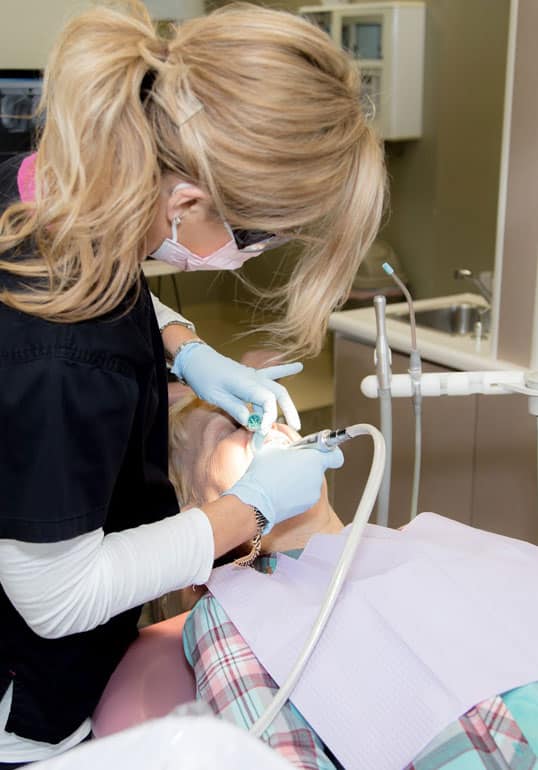The Process Involved in Obtaining Oral Veneers Explained
The procedure of acquiring oral veneers is a multifaceted trip that begins with a preliminary examination, where both oral health and aesthetic goals are completely analyzed. As the treatment proceeds, careful tooth preparation is critical, along with the provision of short-term veneers for security.
Initial Assessment
The preliminary assessment offers as an important foundation for the success of oral veneers. During this consultation, the dentist carries out an extensive examination of the individual's dental wellness, that includes assessing the condition of the teeth, gum tissues, and general bite. This complete assessment is important to figure out whether dental veneers are a suitable alternative for the individual.
Along with the clinical assessment, the preliminary appointment offers an opportunity for people to reveal their aesthetic goals and worries. The dentist will certainly discuss the various kinds of veneers available, such as porcelain and composite resin, and lay out the benefits and limitations of each option. This conference allows for the facility of relationship between the individual and the dental practitioner, fostering an atmosphere of trust and open communication.

Treatment Preparation
Therapy planning for oral veneers involves a mindful and methodical technique to make certain ideal outcomes customized to the person's special demands. This phase is essential for achieving the preferred aesthetic and useful outcomes. Initially, the dentist assesses the individual's dental background, worries, and expectations to develop a thorough understanding of their needs.
Following this, diagnostic devices such as Photos, impacts, and x-rays are utilized to review the problem of the teeth and bordering frameworks. These analyses aid the dental practitioner determine the appropriate sort of veneers, whether porcelain or composite material, based upon factors such as sturdiness, translucence, and the individual's lifestyle.
Aesthetic factors to consider play a significant duty in treatment planning. The dentist works very closely with the individual to choose the ideal shade, form, and size of the veneers, guaranteeing they enhance the individual's face attributes and overall smile. Additionally, a therapy timeline is established, outlining the essential visits and treatments.
Inevitably, reliable therapy planning not just deals with the technological aspects of veneer application but also focuses on patient comfort and satisfaction, establishing the stage for an effective transformation of their smile.
Tooth Preparation
Preparing the tooth is a critical step in the veneer procedure, as it guarantees a proper fit and improves the longevity of the repair. This stage usually begins with a detailed exam of the tooth, consisting of a conversation of the desired end result and any kind of particular issues the patient may have. The dentist will assess the tooth's framework and health to determine the appropriate strategy.
Once the evaluation is complete, the dental professional will continue with the preparation, which entails getting rid of a slim layer of enamel from the front and sides of the tooth. This reduction generally varies from 0.5 to 1 millimeter, depending upon the sort of veneer and the individual's dental makeup. The elimination of enamel is vital, as it produces area for the veneer, enabling it to sit flush against the tooth and making certain a natural look.
After why not try these out the enamel is formed, impacts of the ready tooth are taken, which will be made use of to make the personalized veneer. This careful preparation not only aids in achieving an exact fit yet also contributes to the general visual allure and useful integrity of the final restoration.
Short-term Veneers
During the veneer process, short-lived veneers play an important function in connecting the gap in between the tooth prep work and the placement of the last reconstruction. After the dentist prepares the teeth by getting rid of a percentage of enamel, momentary veneers are crafted to protect the underlying framework while guaranteeing visual continuity.
These short-term restorations are typically made from acrylic or composite resin products, providing an all-natural look and practical benefits. They serve important functions: preserving the positioning of the teeth, avoiding level of sensitivity, and preserving the general oral health during the waiting period for the last veneers. Veneers. Furthermore, short-term veneers assist people visualize the expected outcomes, permitting for changes fit or shade before the permanent veneers are put
The application of temporary veneers is a straightforward treatment. The dental practitioner will firmly bond them to the ready teeth, ensuring a comfortable fit. Clients are suggested to stick to specific treatment directions, such as staying clear of sticky or difficult foods, to maintain the integrity of the temporary restorations. Generally, momentary veneers are vital in making sure a seamless transition to the last oral veneer therapy, leading the way for an improved smile.
Last Placement
The final positioning of oral veneers marks a crucial moment in the aesthetic improvement process, as people change from momentary restorations to their irreversible services. This procedure usually takes place after the oral research laboratory has diligently crafted the veneers to match the person's one-of-a-kind oral framework and preferred visual.
On the day of positioning, the dentist will initially examine the fit and color of the veneers, ensuring they line up completely with the bordering teeth. After confirming that the veneers fulfill the preferred specs, the dentist will completely clean up the tooth surface areas to remove any kind of particles or sticky residues.
Next, an unique dental adhesive is applied, followed by the mindful positioning of each veneer onto the matching tooth. As soon as in position, the dentist will certainly use a curing light to activate the bonding representative, securely attaching the veneers.
Final Thought
In conclusion, the process of acquiring dental veneers includes numerous necessary actions, consisting of a first assessment, in-depth treatment preparation, tooth preparation, the application of temporary veneers, and the final positioning of custom veneers. By sticking to this structured strategy, people can attain check my site a natural and attractive smile, significantly enhancing their overall dental look and boosting confidence.

Generally, short-lived veneers are essential in guaranteeing a smooth shift to the last oral veneer treatment, paving the method for an read what he said improved smile.
In verdict, the procedure of acquiring oral veneers incorporates a number of essential steps, including a first assessment, in-depth treatment preparation, tooth prep work, the application of short-lived veneers, and the final placement of customized veneers.
 Alana "Honey Boo Boo" Thompson Then & Now!
Alana "Honey Boo Boo" Thompson Then & Now! Katie Holmes Then & Now!
Katie Holmes Then & Now! Gia Lopez Then & Now!
Gia Lopez Then & Now! Richard Thomas Then & Now!
Richard Thomas Then & Now! Brooke Shields Then & Now!
Brooke Shields Then & Now!